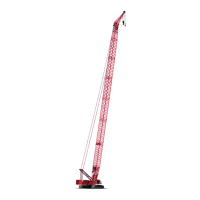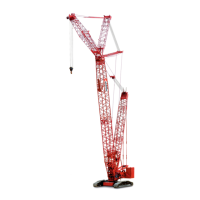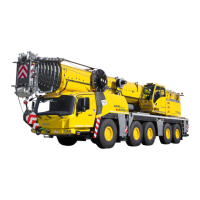OPERATING CONTROLS AND PROCEDURES 16000 OPERATOR MANUAL
3-28
Published 05-09-17, Control # 011-29
LIMIT DEVICES
See Table 3-2 and Table 3-3 to determine which limit bypass
switch bypasses a given limit.
Boom Up Limit
Automatically stops the boom when it is raised to the
following maximum angles:
PAST PRODUCTION
• 83° for boom with or without fixed jib (without luffing jib)
when boom up limit can be bypassed.
• 87° for boom with luffing jib when boom up limit can be
bypassed.
CURRENT PRODUCTION
• 84° for boom with or without fixed jib (without luffing jib)
when boom up limit cannot be bypassed.
• 88° for boom with luffing jib when boom up limit cannot
be bypassed.
The boom can be lowered after the limit is contacted.
LIMIT BYPASS TEST: Perform the following test to
determine if the boom up limit on your crane can be
bypassed or not:
1. Lower the boom onto blocking at ground level.
2. Have an assistant push the boom stop rod in to trip the
boom up limit switch open.
3. Rotate limit bypass key (D3) to the bypass position and
hold.
4. Try to boom up SLOWLY — do not raise the boom any
higher than necessary to perform the test:
a. If the boom rises, your boom up limit can be
bypassed.
b. If the boom does not rise, your boom up limit cannot
be bypassed.
5. The test is complete: release the limit bypass key and
the boom stop rod to the normal operating positions.
Block-Up Limit
Automatically stops the boom or luffing hoist from lowering
and the load drums from hoisting if the load contacts a
block-up limit switch.
The load on the corresponding drum can be lowered and the
boom or luffing jib can be raised after a block-up limit switch
is contacted.
The appropriate limit bypass switch must be turned to the
bypass position before a load can be hoisted above the limit.
Luffing Jib Up Limit
Two luffing jib up limits are provided:
• JIB MAXIMUM UP 1 (maximum working angle): this
programmed limit automatically stops the luffing jib when
the boom to jib angle is 169°.
The appropriate limit bypass switch must be turned to
the bypass position to allow the jib to be raised an
additional 1.5° to JIB MAXIMUM UP 2 limit.
• JIB MAXIMUM UP 2 (maximum angle): automatically
stops the luffing jib when the boom to jib angle is 170.5°.
This limit can be bypassed only when the boom is below
50° (during luffing jib raising and lowering procedure).
The luffing jib can be lowered after either limit is contacted.
WARNING
Falling Boom/Jib Hazard!
If you bypass the boom up limit for any reason, DO NOT
allow physical boom stops to bottom out. Boom butt could
be damaged, causing boom and jib to fall over
backwards.
Crush Hazard!
Maintain constant communication between operator and
assistant during the following steps.
Stay clear of moving parts.
WARNING
Two-Blocking Hazard!
If it is necessary to hoist a load above block-up limit, do so
slowly with extreme caution to prevent two-blocking.
Do not hoist load above minimum block clearance given
in Range Diagram (see Capacity Chart Manual).
Do not use limit bypass switch to lower boom or luffing jib
after block-up limit is contacted; two-blocking could occur,
causing load to fall.
WARNING
Falling Boom/Jib Hazard!
Proceed slowly when operating the luffing jib above the
JIB MAXIMUM UP 1 limit.
Do not raise luffing jib above JIB MAXIMUM UP 2 limit.
Structural damage will occur, possibly causing boom and
luffing jib to be pulled over backwards.

